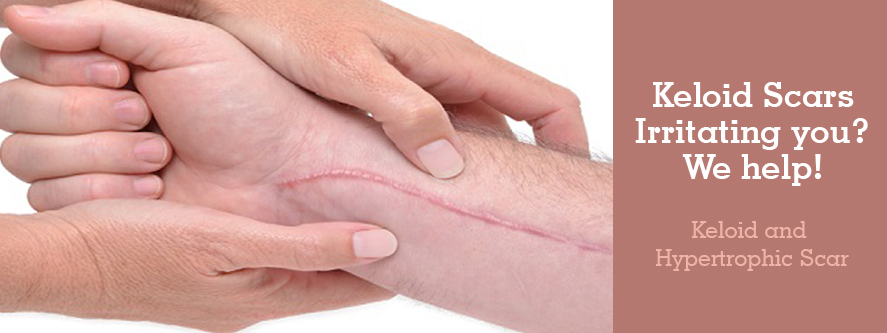Keloid And Hypertrophic Scar

Keloids are overgrown scars left from skin injuries, surgical incisions, lacerations or burns. They can appear anywhere on the body but are most common over the breastbone, on the earlobes & shoulders.
Keloids can result from inflammation after surgical incisions, ear piercings, tattoos, pimples, ingrown hairs or from simply bumping into an object and causing trauma to an area of the body. The initial cause may never be remembered but a Keloid is hard to miss. Keloids form when the body fails to stop creating new tissue known as fibrous protein or collagen – during healing. Usually the body knows when to stop this process, but some people are genetically pre-disposed to Keloid growths resulting in a scar that may be thick, raised and extensive. It can itch, sting or burn and interfere with movement if large enough. They are often red or darker in color than the surrounding skin and are tough.
The term is coined from the Greek word cheloides, meaning crab’s claw .Hypertrophic scars are similar, but are confined to the wound borders and usually regress over time .Scar hypertrophy usually appears within a month of injury, whereas keloids may take three months or even years to develop. Both represent abnormal responses to dermal injury, with exuberant deposition of collagen. The treatments for Keloid and hypertrophic scars are similar, but hypertrophic scars have a better prognosis with age.
Patients at high risk of keloids are usually younger than 30 years and have darker skin. Sternal skin, shoulders and upper arms, earlobes, and cheeks are most susceptible to developing keloids and hypertrophic scars. High-risk trauma includes burns, ear piercing, and any factor that prolongs wound healing
BENEFITS OF KELOID REMOVAL:
- Keloid Removal is a safe, commonly performed procedure
- Keloid Removal today employs several advanced – improved techniques
- Keloid Removal results in minimal, visible scarring
- Keloid Removal surgical & post-surgical techniques today help to minimize Keloid recurrence & improve existing Keloid scars
- Keloid Removal has enhanced self-esteem & confidence in thousands of people
Hypertrophic Scars Vs. Keloids
Hypertrophic scars |
Keloids |
| Remain confined to border of original wound | Extend beyond border of original wound |
| Arise in any location; commonly occur on extensor surfaces of joints | Commonly occur on the sternal skin, shoulders and upper arms, earlobes, and cheeks |
| Regress with time | Grow for years |
| Flatten spontaneously in time | Remain elevated more than 4 mm |
| Appear within one month | Appear at three months or later |
| Less association with skin pigmentation | More common in darker skin types |
WHO IS A GOOD CANDIDATE FOR KELOID REMOVAL?
Any physically healthy man or woman who suffers with Keloids and desires removal of them could be an ideal candidate for Keloid Removal procedure. You must be mature and realistic in your expectations.
Keloid And Hypertrophic Scar Treatment in Delhi
There are several options employed today based upon the size and location of the Keloid. We will use the correct technique/ treatment for your individual needs. Treatments used include:
- Corticosteroid injected directly into the tissue typically 3-4 treatments spaced about 1 month apart will reduce a raised Keloid to a flat scar and reduce redness, itching and burning.
- Surgical Removal is used for larger, more extensive formations. Technique involved may employ a scalpel, electric knife or laser removal.
- Post-Surgical Complimentary Treatments are often used to minimize Keloid recurrence after surgical removal. These treatments include: silicone sheet dressings applied directly to the skin around the incision; compression therapy the mechanically flatten the scar formation, topical imiquimod or advanced injectables such as bleomycin, interferon or 5-fluorouracil. These drugs work at the level to disable the Keloid tissue formation process.
- Laser Excision followed by monthly intralesional steroid injections alone or in conjunction with imiquimod.
- PULSED DYE LASER
Treatment of keloids with short-pulsed, 585-nm pulsed dye laser appears to be most effective if used early and in conjunction with other techniques. Laser-treated portions of keloidal median sternotomy scars showed significant improvement in erythema, pruritus, and scar height compared with untreated portions of the same scars, and these improvements persisted for at least six months.The principal effect of a pulsed dye laser is on scar microvasculature, reducing erythema and pruritus and improving skin texture.
Keloid And Hypertrophic Scar Frequently Asked Questions:
Why Do People Have Keloids Removed?
Keloids are typically unsightly, can itch, sting or burn and many times inhibit normal function depending upon its location.
Why Do Keloid Form After Injury or Surgery?
This is not completely understood but it is known that Keloids are more common among dark skinned people typically African and Asian. There seems to be a genetic tendency among these ethnic groups for Keloids to form.
What Happens That Causes Keloid Formation?
Keloids form after an injury, being bumped, skin friction or surgery. Keloids form around pimples, tattoos, ingrown hairs and ear piercings. While the body normally knows when to stop producing new tissue following insult people prone to Keloid formation don’t seem to have that same turn off mechanism and tissue keeps growing into Keloid formations.
Which Procedure will be used For My Keloid Removal?
The correct method of removal for you is determined during your personal consultation .Each treatment is individualized to ensure optimum natural looking results.
What Downtime Is Involved In Surgical Keloid Removal?
Patients are typically back to work in 1-2 days with stitches removed in a few days.
